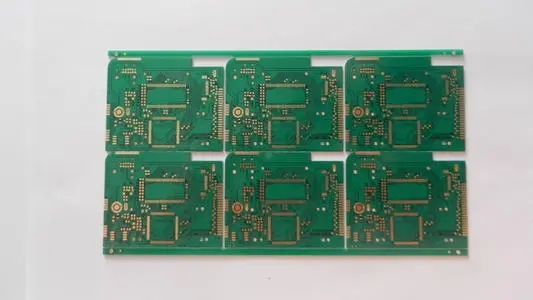許多PCB工程師經常繪製電腦主機板,並且非常精通Allegro等優秀工具。 然而,遺憾的是,他們很少知道如何控制阻抗以及如何使用工具進行信號完整性分析。 對於IBIS模型,我認為真正的PCB主控器應該是信號完整性專家,而不僅僅是停留在連接線上,通過過孔,很容易佈置一塊電路板,但很難佈置好一塊。

Small information
After determining the number of power, 接地和訊號層, 它們的相對排列是每個PCB工程師都無法回避的話題;
分層的一般原則:
組件表面(第二層)的底部是接地層,為頂層佈線提供設備遮罩層和基準面;
所有訊號層盡可能靠近地平面;
儘量避免兩個訊號層直接相鄰; s
主電源應盡可能靠近主電源;
考慮了層合結構的對稱性.
用於主機板的層佈局, 現有的主機板很難控制並行長距離佈線. For the board-level operating frequency above 50MHZ (refer to the situation below 50MHZ, appropriately relax it), it is recommended to arrange the principle:
The component surface 和 welding surface are a complete ground plane (shield);
沒有相鄰的平行佈線層;
所有訊號層盡可能靠近地平面;
鑰匙訊號靠近地面,不穿過隔板.
注意:設定特定 PCB層, 應靈活掌握上述原則. 基於對上述原則的理解, 根據單板的實際要求, 例如:是否為關鍵佈線層, 電源, 需要劃分地平面, 等., 確定層的排列, 不要只是複製或拿起它.
The following is a specific discussion on the arrangement of the veneer layers:
*Four-layer board, 首選方案1, available plan 3
Scheme Number of power layers Number of ground layers Number of signal layers 1 2 3 4
1 1 1 2 S G P S
2 1 2 2 G S S P
3 1 1 2 S P G S
Scheme 1 The main selection layer setting scheme of the four-layer PCB of this scheme, 組件表面下方有一個接地層, 所述關鍵訊號優選地佈置在頂層; 至於層厚設定, the following suggestions are provided:
To meet the impedance control core board (GND to POWER) should not be too thick to reduce the distributed impedance of the power supply and ground plane; to ensure the decoupling effect of the power plane; in order to achieve a certain shielding effect, 有些人試圖把電源和地平面放在頂部, 底層, 那就是, the solution 2:
In order to achieve the desired shielding effect, this solution has at least the following defects:
The power supply and ground are too far apart, and the power plane impedance is large
The power supply and ground plane are extremely incomplete due to the influence of component pads, 等.
The signal impedance is not continuous due to the incomplete reference plane
In fact, 由於大量表面貼裝設備, 當器件越來越密集時,這種解決方案的電源和接地很難用作完整的參攷面, 並且預期的遮罩效果難以實現; 解決方案2的使用受到限制. 但在個別董事會中, 方案2是最好的圖層設定方案.
The following is a use case of Option 2;
Case (special case): During the design process, 出現以下情况:
A、整個電路板沒有電源平面,只有GND和PGND各占一個平面;
B、整個電路板易於接線,但作為介面濾波板,必須注意接線的輻射;
C、該板具有較少的SMD組件,其中大多數是挿件。
analyze:
1. 因為電路板沒有電源板, 不存在功率平面阻抗問題;
2、由於SMD元件數量較少(單面佈局),如果表層做成平面層,內層佈線,則基本保證了基準面的完整性,第二層可以用銅鋪設,以確保少量頂層佈線基準面;
3. 作為介面濾板, 必須注意PCB佈線的輻射. 如果內層佈線, 表層為GND和PGND, 接線遮罩良好, and the radiation of the transmission line is controlled;
In view of the above reasons, 在佈置該板的層時, 我們决定採用方案2, 即:GND, S1, S2, 和PGND. 因為表層上還有一些短痕迹, 底層是一個完整的地平面, 我們在S1中,佈線層用銅鋪設,以確保表面佈線的基準面. 在五個介面濾板中, 基於與上述相同的分析, 設計師决定採用方案2, 這也是一個經典的圖層設定.
列舉上述特例是為了告訴大家,我們必須理解分層原則, 而不是機械地複製它.
方案3:該方案類似於方案1, 適用於主要部件在關鍵訊號的底部佈局或底部佈線的情况; 一般來說, this scheme is restricted;
*Six-layer board: preferred option 3, 可用選項1, 備選方案2, 6層板4個, 首選方案3, 優選佈線層S2, 然後是S3和S1. 主電源及其相應接地位於第4層和第5層. 設定層厚度時, increase the spacing between S2-P and reduce the spacing between P-G2 (correspondingly reduce the spacing between G1-S2 layers), 為了降低功率平面的阻抗, reduce the impact of the power supply on S2;
When the cost requirements are high, 可以使用解決方案1, 優選佈線層S1, S2, 然後是S3, S4.與解決方案1相比, 解決方案2確保電源和接地層相鄰,以降低電源阻抗, 但是S1, S2, S3, S4全部暴露, only S2 has a better reference plane;
For the occasions where the local and small signal requirements are higher, 選項4比選項3更合適. 它可以提供出色的佈線層S2.
*Eight-layer board: preferred plan 2, 3, available plan 1
In the case of a single power supply, 與解決方案1相比,解決方案2减少了相鄰的佈線層, 新增相應接地附近的主電源, 並確保所有訊號層都與地平面相鄰. 成本是:犧牲佈線層; 對於雙電源, 建議使用解決方案3. 選項3考慮了沒有相鄰佈線層的優勢, 對稱層壓結構, 和相鄰的主電源對地, 但S4應减少關鍵接線; 選項4:沒有相鄰的佈線層, 電壓結構是對稱的, 但功率面阻抗高; 3-4, 5-6應適當新增, and the layer spacing between 2-3 and 6-7 should be reduced;
Option 5: Compared with Option 4, 它確保電源和接地層相鄰; 但S2和S3相鄰, and S4 uses P2 as the reference plane; there are fewer key wiring at the bottom and the lines between S2 and S3
The above is an introduction to the points that PCB engineers need to pay attention to. Ipcb也提供給 PCB製造商 and PCB製造 科技.